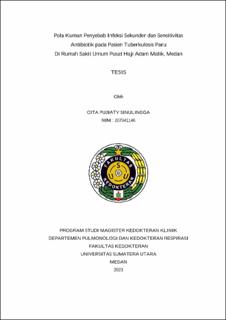Pola Kuman Penyebab Infeksi Sekunder dan Sensitivitas Antibiotik pada Pasien Tuberkulosis Paru di Rumah Sakit Umum Pusat Haji Adam Malik, Medan

Date
2023Author
Sinulingga, Cita Pujiaty
Advisor(s)
Sinaga, Bintang Yinke Magdalena
Siagian, Parluhutan
Metadata
Show full item recordAbstract
Background : Bacterial and fungal secondary infections are also the most important complications in patients with pulmonary tuberculosis. In certain studies, it was found that secondary infection in tuberculosis can delay the healing time of tuberculosis, lead to complications, and may contribute to an increased risk of premature death in pulmonary tuberculosis patients.
Methods : This study design is Cross-sectional descriptive research, data was collected using medical records, analyzed by chi-square through SPSS 25. The study participants were pulmonary tuberculosis patients who had sputum culture data and TCM results treated at Haji Adam Malik General Hospital on June 1 2020 until May 31, 2022..
Result : Most bacterial secondary infections in TBSO (23.8%) and TB RO (17.8%) were klebsiella pneumonia ssp pneumonia. While the most secondary fungal infections were caused by Candida albicans, namely: TBSO (21.2%) and TBRO (17.8%). The most sensitive antibiotic for TBSO was amikacin (46.4%), while the most frequently resistant was ampicillin ( 35.2%) while the most sensitive antibiotic for TBRO was amikacin (42.2%), and the most resistant was cefotaxime (31.1%). The most sensitive antifungal is flucytosine (47.5%). Voriconazole has a resistance rate (5.0%). Whereas in TBRO, Voriconazole is the most sensitive (22.2%) compared to other antifungals.
Conclusion : In TBSO who experienced secondary infections, the majority had bacterial growth (66.3%) with mixed secondary infections (38.8%), whereas in TBRO, more did not experience secondary bacterial or fungal infections.
